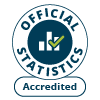NHS dental services: October to December 2024 and January to March 2025
Number of patients receiving NHS dental treatment, the type of treatments provided and the numbers of NHS dentists for October 2024 to March 2025.
This file may not be fully accessible.
In this page
Background
The National Institute for Health and Care Excellence (NICE) recommends that adults are recalled for dental check-ups at intervals of 3 months to 24 months depending on the individual’s oral health status. The guidance also recommends that the longest recall period for children (aged under 18) is no longer than 12 months.
Therefore, statistics on adults treated are based on the previous 24-month period; statistics for children refer to the previous 12-month period.
Each patient is counted only once in the patients treated data even if they have received multiple episodes of care during the reference period. All courses of treatment are counted in the activity measure, even if the same patient had multiple treatments.
Patients may be treated outside of their resident health board and orthodontic patients are included.
Summary
The percentage of Welsh children treated by an NHS dentist continues to increase modestly each quarter, while the percentage of Welsh adults treated has remained broadly stable over the last 18 months.
The number of courses of treatment provided decreased marginally in the latest quarter, but it has remained broadly stable over the previous two years, with small quarterly variations.
Main points
Patients treated in a 12 and 24-month period
Data refers to Welsh resident patients treated at NHS dental practices in Wales and England only. Any non-Welsh resident patients treated in Wales are not included in this measure but are included on separate StatsWales table showing data for all patients treated in Wales.
Figure 1: Percentage of adults and children treated in rolling 24-month and 12-month periods, 31 March 2019 to 31 March 2025 [Note 1]
Description of Figure 1: Line charts showing the percentage of both adults and children treated since the COVID-19 pandemic has increased but remains below pre-pandemic levels. The percentage of children treated has continued to increase slightly in each period, while the percentage of adults treated has remained largely unchanged in recent periods.
Source: FP17W form, NHS Business Services Authority; mid-year population estimates, Office for National Statistics
[Note 1] Adults refers to those aged 18 years or older. Children refers to those aged 0 to 17 years.
Welsh resident children treated in a 12-month period by local health board (StatsWales)
Welsh resident adults treated in a 24-month period by local health board (StatsWales)
Treatments were recorded for more than 1 million adults in the 24-month period that ended on 31 March 2025. This is equivalent to 40.5% of the adult population and is 0.3 percentage points lower than in the 24-month period that ended on 31 March 2024.
There were also just over 300,000 treatments for children in the 12-month period that ended on 31 March 2025. This is equivalent to 48.5% of children living in Wales and is 2.8 percentage points higher than in the 12-month period that ended on 31 March 2024.
New patients treated
Data for ‘new patients’ is published on StatsWales.
New patients are defined as: A unique count of patients at each NHS dental contractor who completed a Band 1, 2, or 3 treatment with a complete ACORN in the year, whose previous Band 1, 2, or 3 treatment at the contractor was completed more than 48 months prior to the ACORN; or who have not previously been treated by the NHS dental contractor.
For the financial year to date (1 April 2024 to 20 March 2025) nearly 140,000 new patients had routine treatments in Wales.
While new patients are unique counts for each specific dental contractor, it is estimated that around 80% of new patients in the financial year to date did not have a separate Band 1, 2 or 3 treatment at another Welsh contractor in the previous 4 years.
A further 90,000 urgent treatments were also provided to new patients in the year to date.
Activity
Activity statistics refer to all NHS courses of treatment provided by dental practices in Wales. It includes treatments provided to patients that did not live in Wales at the time of the treatment but does not include any privately funded treatments.
Figure 2: Number of courses of treatment provided per quarter, October to December 2015 to October to December 2024
Description of Figure 2: Line chart showing that the number of courses of treatment provided each quarter decreased sharply during the COVID-19 pandemic. While the number of treatments subsequently increased between late 2020 and early 2023, they have since remained broadly stable, below the pre-pandemic level.
Source: FP17W form, NHS Business Services Authority
Number of courses of treatment by quarter ending March each year (StatsWales)
During the quarter October to December 2024, there were just fewer than 350,000 individual NHS dental courses of treatment delivered to both adults and children. This is a decrease of 1.0% compared to the same period last year.
The number of courses of treatment in the quarter October to December 2024 was over a third (37.9%) lower than the number in the last quarter largely unaffected by the pandemic (January to March 2020).
Note that data for all quarters in the financial year 2024 to 2025 will be revised in the next publication, when data for the full financial year is available.

